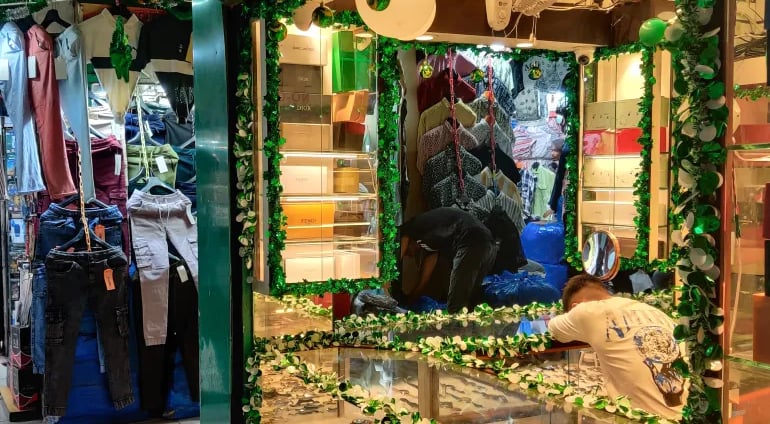Add your promotional text...
India’s Luxury Boom and the Rising Tide of Counterfeit Goods: A Market at Crossroads
Synopsis: India’s booming luxury market, with brands like Louis Vuitton and Hermès rapidly expanding, is shadowed by a thriving counterfeit trade. From bustling local markets to Instagram sales, fake goods are infiltrating the retail landscape, challenging brands and authorities alike. This blog explores the growth of India's luxury sector, the counterfeit economy, and the uphill battle to protect brand integrity.
INVESTMENT IDEAS
By Runjhun Tripathi
11/29/20243 min read


The Rise of India’s Luxury Market: A Glimpse of Prosperity
India's luxury market is experiencing unprecedented growth, driven by increasing affluence among the middle class and elite. Leading international brands like Louis Vuitton, Hermès, and Christian Louboutin are investing heavily in India, solidifying the country’s position as a key player in the global luxury ecosystem.
By 2024, India’s luxury market is expected to reach $17.6 billion, growing at a compound annual growth rate (CAGR) of 3.16%【Source: Statista】. High-end retail spaces such as Mumbai’s Jio World Plaza epitomize this growth, offering premium experiences with personal shoppers and butler services.
However, this promising trajectory comes with a significant challenge—an equally thriving counterfeit luxury goods market.
Counterfeit Trade: The Dark Side of Luxury’s Expansion
As the demand for luxury products grows, so does the market for counterfeits. From the bustling streets of Kolkata’s Fancy Market to the virtual reels of Instagram influencers, counterfeit goods have permeated every corner of India’s retail sector.
Iconic Items at a Fraction of the Cost: Products like Christian Louboutin's $1,800 spiked loafers are sold in counterfeit markets for as little as $180.
Notorious Markets Identified: Indian markets such as Delhi’s Palika Bazaar and Kolkata’s Fancy Market have been flagged by the US Trade Representative as hotspots for counterfeit goods.
These counterfeit hubs cater to a wide demographic, offering fake Louis Vuitton bags, Rolex watches, and more. Despite occasional police raids and high-profile legal actions, counterfeiters continue to flourish, exploiting weak enforcement and the insatiable demand for affordable luxury.
Social Media: A Game Changer for Counterfeiters
The digital age has revolutionized the counterfeit trade in India. Platforms like Instagram have emerged as major enablers, allowing sellers to showcase and promote counterfeit goods discreetly.
Sophisticated Marketing Ecosystems: Sellers use terms like “AAA quality” or “first copies” to describe their products. They collaborate with influencers, who unbox counterfeit luxury items in professionally edited reels.
Bypassing Algorithms: Counterfeit sellers avoid explicit hashtags to evade detection by platform algorithms, while targeting a tech-savvy audience through direct messages and curated content.
In one striking example, a Delhi-based counterfeit seller amassed over 127,000 followers on Instagram, marketing fake Balmain jackets and Chanel dresses. This underground economy is further bolstered by platforms like IndiaMart, which connect manufacturers and retailers of counterfeit goods.
India’s Laws vs. The Counterfeit Challenge
India’s intellectual property laws, aligned with the World Trade Organization’s TRIPS agreement, impose stringent penalties on counterfeiters. Violators can face fines, imprisonment, or both. Despite these provisions, enforcement remains lackluster.
Legal Battles: Christian Louboutin recently won a case against an Indian boutique producing knockoffs of its iconic shoes. However, such victories are rare and often short-lived.
Ineffective Enforcement: Weak penalties, lack of prioritization by authorities, and rampant corruption create an environment where counterfeiters can operate with minimal risk.
Why Counterfeiting Thrives: The Role of Consumer Aspirations
India’s emerging middle class, which accounts for 31% of the population, has a strong desire to own luxury items but often lacks the financial means. Counterfeit goods offer a way to achieve the status symbol of owning a designer brand without the high price tag.
Affordability vs. Authenticity: A survey revealed that 89% of Indian consumers buy counterfeit luxury items due to affordability and social aspirations.
Trend-Conscious Millennials and Gen Z: These groups, poised to make up half of India’s population by 2030, gravitate towards counterfeit goods as a means to keep up with fast-changing fashion trends.
Even affluent consumers are not immune, often falling prey to counterfeit products marketed as showroom-quality replicas.
The Public Safety and Economic Toll of Counterfeits
Counterfeiting is not just a problem for luxury brands; it has broader implications for public safety and the economy.
Economic Losses: FICCI CASCADE estimates annual tax losses from counterfeit goods in sectors like alcohol, tobacco, and FMCG at $7 billion.
Public Safety Risks: Counterfeit auto parts contribute to 20% of road accidents, while fake antibiotics endanger public health.
Links to Organized Crime: Investigations have revealed that counterfeit operations are often connected to larger criminal networks, including websites hosting illicit content.
How Luxury Brands Are Fighting Back
Luxury brands are taking a multi-pronged approach to combat counterfeiting:
Legal Action: Companies like LVMH and Gucci employ dedicated teams to monitor and address counterfeit activity.
Technological Solutions: QR codes, holograms, and blockchain technology are being used to authenticate products. However, counterfeiters have quickly adapted, creating fake QR codes that mimic genuine ones.
Consumer Education: Educating consumers about the risks and ethical implications of buying counterfeit goods is crucial for reducing demand.
Despite these efforts, the counterfeit industry remains a low-risk, high-reward enterprise, with sellers continuously evolving to outsmart enforcement measures.
Conclusion: The Path Forward for India’s Luxury Market
India’s luxury market is at a crossroads. While the demand for high-end products fuels economic growth, the rise of counterfeit goods threatens brand integrity, consumer safety, and the broader economy.
To sustain the momentum of luxury expansion, stakeholders must address the root causes of counterfeiting. This includes stricter enforcement of intellectual property laws, greater consumer awareness, and bridging the gap between aspiration and affordability.
The battle against counterfeiting is far from over, but with a concerted effort from brands, authorities, and consumers, a more authentic and secure luxury market is within reach.
